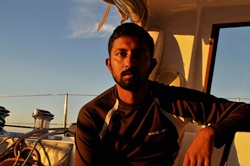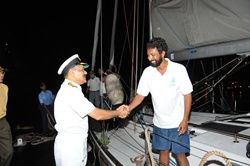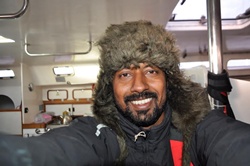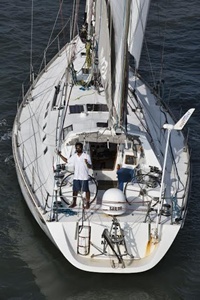Sailing solo around the world in 151 days
13 Oct 2014
As a part of the Sagar Parikrama project of the Indian Navy, Abhilash Tomy, Commander, Indian Navy, undertook an arduous voyage, sailing single-handed around the world to become the first Indian, second Asian and 79th person in the world to complete a solo unassisted non-stop navigation in 151 days. Tomy is a reconnaissance pilot in the Indian Navy who had actually wanted to fly solo around the world someday.
 In 2013 Tomy became the first naval officer in more than 50 years to be awarded the Kirti Chakra, second-highest peacetime gallantry award in India. He was honoured by President Pranab Mukherjee for his remarkable voyage. A motivational speaker, he has delivered over 50 inspiring lectures about his voyage to several corporates and schools including IITs, IIMs and the Tata Institute of Social Sciences. He has also authored a Malayalam book on solo navigation titled Kadal Ottakku Kshanichappol (When the Ocean beckoned me) and has co-authored with Lynn De Souza, a coffee table book, 151 Solitary Days At Sea: Sailing Non-Stop Around The Globe which consists of pictures and blog posts during his voyage.
In 2013 Tomy became the first naval officer in more than 50 years to be awarded the Kirti Chakra, second-highest peacetime gallantry award in India. He was honoured by President Pranab Mukherjee for his remarkable voyage. A motivational speaker, he has delivered over 50 inspiring lectures about his voyage to several corporates and schools including IITs, IIMs and the Tata Institute of Social Sciences. He has also authored a Malayalam book on solo navigation titled Kadal Ottakku Kshanichappol (When the Ocean beckoned me) and has co-authored with Lynn De Souza, a coffee table book, 151 Solitary Days At Sea: Sailing Non-Stop Around The Globe which consists of pictures and blog posts during his voyage.
In this interview with Swetha Amit he talks about his inspiration behind the voyage, his preparations before embarking on this journey and the prospects of sailing as a sport in India.
You are the first Indian, second Asian and 79th person in the world to complete a solo unassisted non-stop circumnavigation under sail. What was the inspiration behind this arduous journey?
As a kid I was always attracted to the sea, since my dad was in the Navy and we have always lived by the sea. During my growing up years, I would read books by Robert Louis Stevenson and stories that talked about young people running away from homes, working in ships and having an adventure. All that fascinated me. In school when I was in class two or three, I got to know about the expedition of 'Trishna', a Swan 37 Yacht (belonging to the Corps of Engineers of the Indian Army) which embarked on a circumnavigation voyage and was considered to be the first achievement by an Indian crew. I was at a very impressionable age when that happened. So one day I went and told my mom that, this is what I want to do and that's how it started.
In 1999 I read about a solo race which propelled the idea within me about sailing solo around the world. In 2009 Commander Dilip Donde was doing a solo circumnavigation with stops. He wanted my assistance to which I immediately consented and joined in. During the voyage, the idea of a non-stop circumnavigation cropped up and when he asked me, I said yes, and that's how it all began.
Could you tell us a bit about your background before joining the Indian Navy?
I was a student before this. I joined the Naval Academy right after my class twelfth and graduated in 1999. Post my graduation, I did one year training in ships and in 2000 I got my first stripes.

My father and uncle were both in in the Navy. However unlike other instances where the son was expected to follow suit, my dad was keen that I pursue engineering or medicine. I was considered to be a bright student since I had cleared both engineering and medical entrance exams in my first attempt after my Class twelfth. So they expected me to pursue a career in those areas or become an IAS officer.
They felt in order to be in the Navy, one was required to have a certain skill set and be street smart. Since I was considered to be more in the intellectual space, they felt it would not be easy for me. Being in the Navy tends to give one a very practical idea to life unlike other fields. If you work elsewhere, you are a highly specialised person who just needs to focus on your job alone. For instance, if you are a coder you just need to know your coding and that's about it.
However it is quite different in the Navy, where you need to possess multiple skillts. Here, many people come from different parts of the country. Therefore you need to understand people, know how to sort their problems and make them work for your organisation. You also need to know other aspects from world affairs to accounting, etc.
What were your preparations before embarking on this journey?
The preparations began almost two years before I started on this journey. Though I knew how to sail, it takes about three - four years to get to that sort of skill level required for circumnavigation.
I joined the boat - INSV Mhadei in 2009 when I started working with Commander Donde and learnt about the boat in detail. I realised that it was not just about sailing or how you set your sail or machinery inside the boat. You need to know everything about it. The boat is equipped with a lot of things right from an engine motor, satellite communication, navigation systems to a cooking gas. So you need to know how the cooking range works. You also need to understand about the thermocouple [a temperature-measuring device]; otherwise you won't know how to light a stove the entire time you are there on the boat. You also need to know everything about your bathrooms, the plumbing and the pumps.
After this, both Commander Donde and I along with two other people sailed to Brazil. We had a stop at Cape Town where Commander Donde got off along with one of the persons accompanying us. I then became the skipper from thereon and sailed across the Atlantic with the remaining person. On our way, we happened to see about 7-8 boats crossing us. However a lot of things happened and we saw one boat sinking.
By God's grace, we were the only ones who managed to cross safely. We then reached Cape Town where the remaining person got off. From there on, I sailed the boat alone to Goa. Then I did a short trip to Malaysia and Thailand. So that was my training as far as sailing was concerned.
As far as the preparations for the boat was concerned, I had to carry food and water for six months. I had to plan how to source my water. I had to identify spare parts, for every equipment on the boat, in case any servicing and repairing was required. With regards to medicine, I had to undergo a short course in learning how to treat myself. I also had to learn from doctors on how to conduct a CPR (cardiopulmonary resuscitation) on myself.
Could you tell us more about your boat INSV Mhadei which took you on this voyage?
She is a 'Van de Stadt Tonga 56'. It was built under Commander Donde's supervision by a good maker in Goa named Ratnakar Dandekar at the boat yard of Aquarius Fibreglas Pvt. Ltd. The navy bought this design specifically for Commander Donde's circumnavigation.
The sloop is about 56 feet long. Mhadei weighs around 23 tons and is made of wood core fibreglass. It has a suite of 8 sails. The length is about 21 m and the draft is 2.7 metres above waterline. It's a state of the art boat which has a lot of modern equipment fitted inside, making it suitable for circumnavigation.

There are facilities like a 3-satellite communication systems, navigation equipment from Ray Marine and has facilities for paperless navigation and internet broadband and telephone anywhere in the world. There is also a generator and a motor to get the boat in and out of the harbour, desalinator for making fresh water and an inboard diesel engine for power generation and propulsion.
What kind of food did you carry with you? And how did it manage to last for 5 months?
We had about two years' time to figure out what kind of food to carry. Essentially the breakdown was like this:
- For good weather – suitable food which you can cook and eat such as rice and lentils.
- During bad weather – suitable food would that you can heat and eat such as MRE, freeze and dry food.
- And in times of very bad weather – the ideal food, which you can tear open and eat such as energy bars and dry fruits.
On the basis of this breakdown, we came up with the following list of food to carry:
- Fresh fruits and vegetables that could last for about three weeks without refrigeration such as potatoes, cauliflower, citrus fruits and onions.
- Rice, lentils which needed cooking as there is nothing like freshly-cooked food when you are tired and out.
- Tinned food such as tuna, baked beans which can be consumed as it is or just with minimal cooking.
- MRE from DRDO which come in packets and can be heated in hot water. They are usually curries which t you have along with rice.
- Backcountry Freeze dri food that came from New Zealand. You just add hot water to it and leave it as such for 15 minutes for it to become a meal.
- Snacks like energy bars, chocolates, biscuits, nuts, breakfast cereals, milk powder also constituted the list.
None of the above needed any sort of preserving and they do last for years if not months (other than fresh vegetables and fruits).
Such arduous voyages are synonymous with unpredictability in weather conditions, danger and turbulent waves. How did you overcome such hurdles?
The weather was not unpredictable; in the sense you would come to know if there was a storm. I used to get my daily weather report from a firm in the United States. They would send me a 16-day forecast and the predictions were fairly accurate. If a storm arises, it is going to hit you and there is no way you can avoid it. You just need to have a right approach to them. Also the boat is very well built to weather such storms.
Secondly I had about 27000 miles of sailing and I have sailed through some really bad weather. So that gave me an idea of how to handle the boat in such conditions. Before I set off I was well trained and mentally conditioned for such occurrences. Hence I knew what to expect. In fact I used to have 10metre high waves which were wind generated waves. You just need to keep sailing in such instances. Just imagine you are living in a house which is going up and down 10 metres. It's like sitting on a giant wheel where you sometimes feel like throwing up. In such cases you learn to deal with it as the situation is not under your control.
 What kind of marine life did you encounter during the course of your sail? And how did you manage to sail past the pirates invested area of the ocean?
What kind of marine life did you encounter during the course of your sail? And how did you manage to sail past the pirates invested area of the ocean?
I saw whales, dolphins, albatrosses, flying fish, squids and a lot of such marine life as I sailed through various oceans.
The only pirate-infested waters in the entire voyage was the stretch from Mauritius to India. During this leg I had the cover of naval warships deployed in the area for anti-piracy mission.
What was your daily routine like on the boat? Did you ever get bored anytime?
I would do my meditations in the morning which was followed by breakfast. At 8 am I would get my weather report, based on which I would do my planning. I also had to send the weather report to the naval headquarters. After that I would walk around the boat to see the things that needed attending to. Post-lunch again, I would continue working. By the time it was 6 pm, I would be preparing the boat for the night. The weather report would come in by 7 pm again and it took me about 2 hours to check it, after which I would be done for the day.
Though this was a routine, you couldn't say I followed the same routine for those 151 days. Being in the boat was like running a kitchen, where there were plenty of things to do. So I was constantly attending to something or the other. When the weather was bad, I had to even plan days when I could use the rest room. It was unimaginably bad. Also since I had to conserve electricity, I would avoid any kind of work by night so that I don't have to switch on any light.
As far as boredom was concerned, I was just bored for four hours in those five months.
There was a small stretch in the Indian Ocean where I was wondering as to what time it was. But other than that, there was plenty to do on the boat. I also carried lot of books. However I couldn't read beyond Australia as it would get so cold that you couldn't keep your fingers out in the open. That's when I started watching movies on my laptop. I had internet, telephone but I never made a phone call except a couple of times. I called my parents on January 26th to wish them on their wedding anniversary.
I maintained my Facebook and blog. It was a necessary evil. You had to do that because you had to tell the world what you were doing and also because of the fact that many people were trying to reach me at that time.
The Navy for instance would call me up every day to ensure I was fine. After a point it got so irritating that I lost my cool. Commander Donde at that time intervened and explained to them that if I needed anything I would call them. I then told them that I would send them two reports in a day to assure them of my safety. That way, they wouldn't have to call me up and check with me on a daily basis.
How did you deal with factors like solitude and loneliness during the journey?
That was not at all a problem. I was happy to be alone and enjoyed the solitude. It's a mental game. It's like somebody putting you inside a cupboard and locking you. As long as you don't panic nothing happens. The moment you panic the game is up. In fact one of my problems was coming back to people. 
After 151 days of solitude in the seas, how challenging is it to get back to the maddening life in the city? Have you changed as a person post this voyage?
After living in immense amount of stress for five months where any moment could have killed you, one realises that it doesn't take much to survive in a city.
So it's rather funny to see people running after the same thing that they were running after six months back, such as material things and fat salary packages, etc. It's like watching another species altogether, say, monkeys fighting over pebbles or birds fighting over something they found. You begin to feel this is not what you are here for and that you would rather be alone. So yes, it is difficult to get back to city life and the rat race.
One thing is for sure. You never are the same person you were before embarking on this journey. You tend to find a different purpose for your existence and that's definitely not buying a lavish house or a luxury car.
Also when you are living in a community, with or without your knowledge, your behaviour is dictated and governed by somebody else. You are constantly responding to something which tends to rob away the time you need to spend with yourself.
Out at sea, there is nobody to question you. So that way you get more time to yourself. You reach a state of equilibrium with rest of the universe. It's a different connect. It's as though you are plugged into something else. There could be a storm outside yet you feel very peaceful on the inside.
What was your feeling when you reached the gateway of India after completing your voyage?
I felt a sense of relief not because I came back home safely. In fact I was very confident about finishing. The day I left I was not worried about coming back. I know I would come back but the question was how. The yardstick of success for me was:
- In those 5-6 months I shouldn't ever question myself at any point in time as to why I undertook such a voyage. I should not reach a point where I was breaking down. If I ever broke down then that would have been considered as a failure.
- Second task I had set for myself was that the boat should be as good as new and there should be no damage to the boat. In 5 months the boat had only the steel fitting that broke and 1 sail that tore. That's about it.
I think in both ways it was a success. In fact the day I returned, if anyone had given me water and food, I could have gone for one more circumnavigation. I had enough diesel as well.
For me, this voyage was a task given by the Navy, which I had completed. As for adventure and a sense of achievement, the entire definition of these words will change post this journey. Achievement is for other kind of people and adventure is about expanding your experiences. Everybody has his or her personal definition of adventure. That's what I realised when I saw my mom step on an escalator for the first time. It was a big adventure for her.
Do you see your 'Life of Pi' like achievement as a source of inspiration for young budding seafarers?
Yes. In fact that was one of the ideas beyond the voyage. My personal aim in life is to get as many people to sail. India has 7,000 km of coastline and good winds. Yet there are very few people who sail. I think it's more to do with the cultural factor. I see sailing as a very good way to develop skills. Anybody who goes to sailing will become self-sufficient in many ways. You develop a lot of patience and it makes you more disciplined.
How do you see the future of women with regards to resorting to a sport like sailing?
One does see women getting into sport a lot more these days as compared to earlier. However it's wrong to expect a country which has just won its Independence take part in Olympics vigorously like other countries. .
All this takes time. We grappled with so many problems in the initial years of existence where prosperity was not seen and the government itself was not sure as to how to let the people run their own lives. There was lot of bureaucracy. But we are changing and as we change we will see a lot of developments taking place.
As far as sailing and women are concerned, I quote what my mentor Commander Donde says, ''The Sea doesn't know whether you are a man or woman.'' It recognizes nothing. It's as simple as that. You cannot cite the excuse of not being able to do it because you are a woman. If you have it in you, you can do a circumnavigation right now.
Now that you are home and dry, what next?
I intend to do a lot more circumnavigations. I also want to go racing around the world.
My Malayalam book has sold some 5000 copies. I have also co-authored a coffee table book with Lynn De Souza, a picture book on my solo non-stop circumnavigation.
I have to write my own book. I don't know when that will happen. Hopefully soon.
| Excerpt from 151 Solitary Days At Sea: Sailing Non-Stop Around The Globe At 13:45 hrs in India and 15:15 hrs on the deck watch, the Mhadei carried me across the longitude of Cape Horn 20 miles to its south marking the end of our passage through the Pacific, through the Chilean SRR, and of Leg Three and crossed us over to the Atlantic, into Argentina's SRR and into Leg four of the voyage. A moment later I hoisted the national flag on the backstay which was followed by a flypast of albatross and cormorants and a steam-past of smiling dolphins. The flag was a happy flag to be fluttering free in fresh breeze so far away from mainland India and its colours contrasted well with the dark shades of the sea and sky. The waves literally chanted lines from the national anthem uchala jaladi Taranga (chanted by the waves of the Ocean). The dense fog tells me that today the Horn wishes only to be sensed not sighted. I can smell the mysteries, hear the triumphs, and taste the tragedies of those that have come here before me. But a clear view must remain an illusion, an image in my mind's eye, to be stored and savoured for another voyage and another day. Horn wants me back. Something tells me that I should at least try to get as close as possible on this historic occasion, so I gybe and head as close as a mile and a half. The Horn lifts its veil of fog and low clouds briefly-enough for the merest glance but not enough to make a good picture - clearly wanting it to be a moment shared only between the two of us. But the great cape does extract a small price by tearing the genoa and claiming a camera when the boat crash gybes and the main sheet entangles with a GoPro. |






















